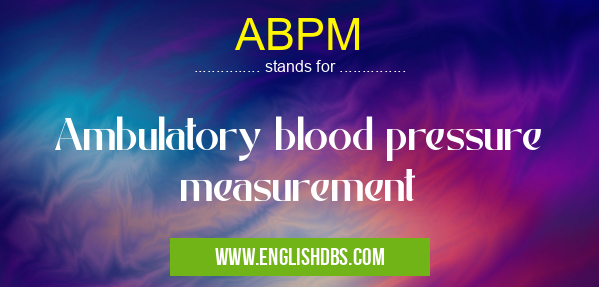What does ABPM mean in CLINICAL MEDICINE
During an ABPM, a small blood pressure monitor is worn on the upper arm. The monitor automatically takes blood pressure readings at regular intervals throughout the day and night. The readings are stored in the monitor's memory and are later downloaded to a computer for analysis.

ABPM meaning in Clinical Medicine in Medical
ABPM mostly used in an acronym Clinical Medicine in Category Medical that means Ambulatory blood pressure measurement
Shorthand: ABPM,
Full Form: Ambulatory blood pressure measurement
For more information of "Ambulatory blood pressure measurement", see the section below.
How ABPM Works
Benefits of ABPM
ABPM offers several advantages over traditional blood pressure measurement in a doctor's office. These advantages include:
- Increased accuracy: ABPM provides a more accurate assessment of blood pressure than a single reading in a doctor's office. This is because ABPM takes multiple readings over a 24-hour period, which helps to reduce the effects of white coat hypertension.
- Improved diagnosis: ABPM can help to diagnose hypertension in people who have normal blood pressure readings in a doctor's office.
- Better assessment of severity: ABPM can help to assess the severity of hypertension and to determine the need for treatment.
- Monitoring treatment effectiveness: ABPM can be used to monitor the effectiveness of antihypertensive medication.
Essential Questions and Answers on Ambulatory blood pressure measurement in "MEDICAL»CLINICAL"
What is ABPM?
Ambulatory blood pressure measurement (ABPM) is a method of monitoring blood pressure over a 24-hour period using a portable device. ABPM provides a more comprehensive picture of blood pressure patterns than traditional office blood pressure measurements, as it captures pressure readings during both daytime and nighttime hours.
Why is ABPM used?
ABPM is used to diagnose and manage hypertension (high blood pressure) by providing a more accurate assessment of blood pressure variability. It can also help identify masked hypertension (high blood pressure that is not detected during office visits) and white-coat hypertension (elevated blood pressure that occurs only during medical appointments).
How is ABPM performed?
ABPM involves wearing a portable blood pressure monitor that automatically takes readings at regular intervals throughout the day and night. The device is typically worn on the upper arm and connected to a cuff that inflates and deflates to measure blood pressure.
What are the benefits of ABPM?
ABPM provides a more complete picture of blood pressure patterns and can help:
- Diagnose hypertension more accurately
- Identify masked and white-coat hypertension
- Monitor blood pressure changes over time
- Adjust medication dosages based on actual blood pressure measurements
- Improve patient adherence to blood pressure management
Are there any risks associated with ABPM?
ABPM is generally safe and well-tolerated. However, some potential risks include:
- Discomfort or skin irritation from wearing the device
- Interference with sleep due to the frequent blood pressure readings
- Incorrect blood pressure measurements if the device is not properly placed or calibrated
Final Words: ABPM is a valuable tool for the diagnosis and management of hypertension. It is a non-invasive, accurate, and convenient method of measuring blood pressure over a 24-hour period. ABPM can help to improve the diagnosis and treatment of hypertension, which can lead to better health outcomes.
